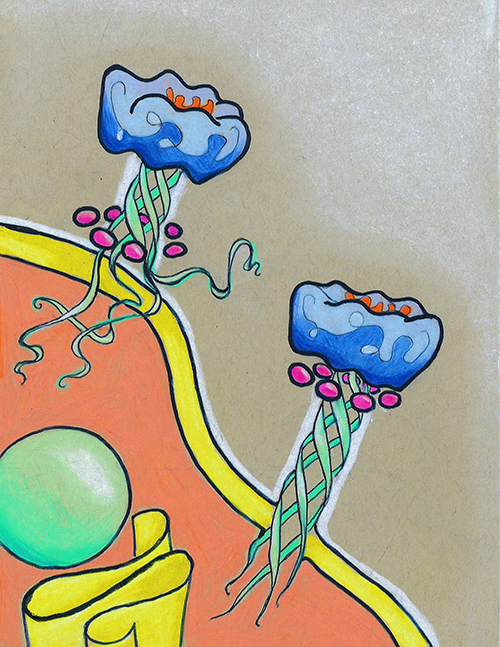Stephen Doster
-

To B or not to B (mature)
By Cassandra Awgulewitsch A 3D drawing of a B cell. From Blausen.com staff (2014). “Medical gallery of Blausen Medical 2014”. WikiJournal of Medicine 1 (2). DOI:10.15347/wjm/2014.010. ISSN 2002-4436. Reproduced under a CC BY-SA 4.0 license. Kristy Stengel, a postdoc in… Read MoreDec. 5, 2019
-

Rathmell named interim chair of Medicine
Dec. 5, 2019, 10:34 AM by John Howser Kimryn Rathmell, MD, PhD, Cornelius Abernathy Craig Professor of Medicine and director of the Division of Hematology and Oncology, has been named as interim chair of the Department of Medicine in the Vanderbilt University School of Medicine. Her appointment is effective Jan. Read MoreDec. 5, 2019
-

Genetic screen in worms reveals critical step in insulin synthesis
Dec. 4, 2019, 1:00 PM Patrick Hu, MD, PhD, identified a previously unknown step in insulin synthesis, providing new clues to diabetes pathogenesis. (photos by Susan Urmy) by Leigh MacMillan The identification of a protein important for insulin synthesis may hold clues for understanding the pathogenesis of diabetes. Although the… Read MoreDec. 5, 2019
-

Study finds ‘frozen’ fear response may underlie PTSD
Nov. 27, 2019, 9:30 AM by Bill Snyder Learned fear responses enable animals — including humans — to flee or freeze in the face of a perceived threat. But if these behaviors persist after the danger lifts, they can become paralyzing and disabling. That’s a key element of posttraumatic… Read MoreNov. 27, 2019
-

Anatomy of a toxin pore
By Jaime Jensen An artist’s rendering of the pore-forming action of a C. difficile binary toxin. Courtesy of the artist. Eve Moll 2019. This article originally appeared in the Nature Research Microbiology Community blog. The bacterium Clostridioides* difficile (C. diff) has been called many things: a superbug,… Read MoreNov. 27, 2019
-

Neil Osheroff elected new IAMSE president
Neil Osheroff, Professor of Biochemistry and Medicine, Vanderbilt University School of Medicine, was recently elected President of the International Association of Medical Science Educators. The IAMSE is a nonprofit professional development society organized and directed by health professions educators whose goals include promoting excellence and innovation in teaching, student assessment, program evaluation, instructional… Read MoreNov. 26, 2019
-

What leads to compulsive alcohol use?
Occasional binge drinking isn’t uncommon, but about 30 percent of all adults exposed to alcohol go on to engage in compulsive drinking behaviors despite negative effects and consequences – a major feature of alcohol use disorder. For years, researchers have sought answers as to why alcohol produces such radically different… Read MoreNov. 22, 2019
-

Study explores potential new class of antidepressants
Study explores potential new class of antidepressants Nov. 21, 2019, 11:10 AM Max Joffe, PhD, left, P. Jeffrey Conn, PhD, and colleagues are studying a new class of antidepressants that may relieve symptoms more rapidly and with fewer side effects. (photo by Joe Howell) by Bill Snyder Researchers at Vanderbilt… Read MoreNov. 21, 2019
-

Grant spurs effort to map biology of Crohn’s disease
Nov. 20, 2019, 4:14 PM by Bill Snyder Vanderbilt University Medical Center (VUMC) has been awarded a three-year, $3 million grant from The Leona M. and Harry B. Helmsley Charitable Trust to map — in unprecedented detail — the biology of Crohn’s disease. Under the terms of the award, which… Read MoreNov. 21, 2019
-

Understanding cell division
Nov. 18, 2019, 8:30 AM by Cayetana Arnaiz Yépez Cytokinesis is the final step of the process of cell division, by which the two new cells are physically separated. This process relies on a structure called the cytokinetic ring, which needs to be linked to the plasma membrane throughout cell division. Read MoreNov. 21, 2019